






































Just in case you were living under a rock, this year is an election year.
This is a big one — a presidential election.
It’s not an overstatement to say the decisions made in Washington, D.C. a ect us all.
Election Day is Nov. 5, so we have a few months before we head to the polls.
But September is special because Sept. 17 is National Voter Registration Day.
If you aren’t registered to vote, this month is the perfect time to do just that.
Mississippi’s electric cooperatives want to help members register because it’s important.
Why?
Too often policy decisions made today disproportionately reflect the interests of large utility companies in urban areas. As members and owners of our co-ops, we understand the distinct local challenges we face, and are uniquely responsive to our communities in ways that other utilities are not.
That’s why we need to register to vote and make our voice known.
We need to make sure both our state and federal lawmakers and regulatory o cials understand our unique cooperative needs, so we can continue to provide reliable and a ordable power to our communities.
Many younger people in the state, who are hitting 18 or are a few years older, might not be registered to vote.
To that end, some of our local electrical cooperatives will be stationed at community colleges to get those folks registered. The future belongs to all of us, so we all need to vote to ensure our priorities, values, and perspectives are addressed.
The Sept. 17 voter registration drives are not the only way your electric cooperatives
want to assist members in having a say in the future course of Mississippi.
We want to help members become better informed voters.
Our Co-ops Vote MS initiative and website makes it easier for members to get informed and to participate in the democratic process.
The website — coopsvotems.com — features quick links to important voting information including where to register to vote, our current elected o cials, what elections are occurring this year, and videos of statewide elected o cials talking about the importance of voting, and what they do on a day-to-day basis.
I’ve said this before, and I’m going to say it again. Voting is a form of participation, and every qualified man and woman in Mississippi should not only cast their vote, but care enough to understand who they are voting for and why.
You have the POWER to Register. Be informed. Vote.
On another quick note, this issue is our second annual travel issue. If you’re looking for something to do on a weekend day, hop on The Natchez Trace Parkway and visit one of the many special locations or sites just o this 444-mile jewel.
We hope you enjoy the issue.

by Michael Callahan
Executive Vice President/CEO Electric Cooperatives of Mississippi


Well look at you great, gorgeous Mississippi! Aren’t you significantly something special to see? Varieties of beautiful greens fill spectacular scenery. Oaks, maples, magnolias, pecans, and pines. Shelter and grace three million friends of mine! Then there’s not so cute and cute crazy critters. That Mississippians hunt with hounds, beagles, and sitters. Hogs, coons, gators, does, and deer are about. Good and bad, but not one critter you’d live without. Especially your people, friendly and fair. The best! Occupy your state north, east, south, and west. Land loaded with wandering water, lakes, and streams. Water sports and fisherperson dreams! Yes, God created this mixed combination. Making Mississippi God’s special creation. Due to heavenly Father’s grace. Designed Mississippi as a nearly perfect place. by Tom Morgan, a resident of Sumrall, and a member of Pearl River Valley Electric.
What’s Mississippi to you?
What do you treasure most about life in our state? Send your brief thoughts to Today in Mississippi, news@ecm.coop or mail to P.O. Box 3300, Ridgeland, MS 39158
Submit your beautiful digital photo of life in Mississippi to Today in Mississippi, news@ecm.coop





The Official Publication of the Electric Cooperatives of Mississippi
Vol. 77 No. 9
OFFICERS
Ron Barnes - President
Brian Hughey - First Vice President
Brian Long - Secretary/Treasurer
Michael Callahan - Executive Vice President/CEO
EDITORIAL STAFF
Lydia Walters - VP, Communications
Steven Ward - Editor
Chad Calcote - Creative Director
Kevin Wood - Graphic Designer
Alan Burnitt - Graphic Designer
Courtney Warren - Graphic Designer
Chris Alexander - Member Services Coordinator
Andy Tuccio - Media Solutions Director
Steve Temple - Social Media Director
Kendle Dean - Administrative Assistant
EDITORIAL OFFICE & ADVERTISING
601-605-8600
Acceptance of advertising by Today in Mississippi does not imply endorsement of the advertised product or services by the publisher or Mississippi’s electric power associations. Product satisfaction and delivery responsibility lie solely with the advertiser.
• National advertising representative: American MainStreet Publications, 800-626-1181
Circulation of this issue: 489,460
Non-member subscription price: $9.50 per year.
Today in Mississippi (ISSN 1052-2433) is published 12 times a year by Electric Cooperatives of Mississippi Inc., P.O. Box 3300, Ridgeland, MS 39158-3300, or 665 Highland Colony Parkway, Ridgeland, MS 39157. Phone 601-605-8600. Periodical postage paid at Ridgeland, MS, and additional o ce. The publisher (and/or its agent) reserves the right to refuse or edit all advertising. The magazine is published for members of subscribing co-ops. The magazine is a bene t of membership.
POSTMASTER: Send all UAA to CFS. (See DMM 507.1.5.2) NON-POSTAL AND MILITARY FACILITIES: send address corrections to: Today in Mississippi, P.O. Box 3300, Ridgeland, MS 39158-3300

www.facebook.com/TodayinMississippi
www.todayinmississippi.com

The Electric Cooperatives of Mississippi Foundation was created by the Electric Cooperatives of Mississippi in 2005 in an e ort to give back to the communities they serve by providing scholarships for engineering students in their junior or senior year of college.
This year, five college students were awarded $2,000 scholarships. Arden Armstrong of Jackson, an electrical engineering major at Mississippi State University; Chris Pope of Leaksville, an electrical engineering student at Mississippi State University; Shay Ramsey of Biloxi, a mechanical engineering major at Mississippi State University; Garrett Minchew of Laurel, a mechanical engineering major at Mississippi State University; and John Alliston of Gulfport, an electrical engineering major at Mississippi State University won the scholarships. Armstrong, Pope, Ramsay, and Minchew are working for Cooperative Energy, while Alliston works at Coast Electric. The students work at the electric cooperatives as part of Mississippi State University’s Co-op engineering program.









U.S. Senator Cindy Hyde-Smith (R-Miss.) recently supported committee approval of a far-reaching bill to strengthen American energy security by reforming the federal permitting process for critical energy and mineral projects in the U.S., according to a news release.
Hyde-Smith serves on the Senate Energy and Natural Resources Committee that marked up the bipartisan Energy Permitting Reform Act of 2024, a measure that would expedite permitting decisions and review of legal challenges to energy, mineral, and electricity production and distribution projects. It was approved 15 to 4.
“The reforms in this legislation are overdue. The citizens of this country and my state will be better o by cutting red tape in the permitting process, providing greater stability in oil and gas production, and enhance energy security overall. That said, I think the bill can still be improved,” Hyde-Smith said.
Of interest to Mississippi, the measure would mandate increased o shore oil and gas lease sales in the Gulf of Mexico, permanently end the Biden administration’s so-called pause on liquified natural gas (LNG) exports, and expedite judicial reviews of federal energy and mineral project authorizations.
Hyde-Smith, in a statement for the record, indicated the need to address concerns raised by electric cooperatives in Mississippi regarding interstate electric transmission reform, specifically citing a state law enacted last year to maintain state jurisdiction over the integrity of electric transmission infrastructure.
“I want to make sure that the voices of our electric cooperatives are being heard, too. Co-ops in Mississippi have raised concerns regarding the changes to Section 401 in this bill, specifically regulatory overreach, cost allocation, and state authority,” Hyde-Smith said.
“We have to be aware of the potential setback the Energy Permitting Bill Act could cause for my state’s control of new transmission projects if FERC’s authority can supersede these state regulations. So as this measure continues to move through the legislative process, I want to ensure that our co-ops are being heard and that their concerns are being addressed,” she said. “We can’t leave our electric cooperatives out of the conversation.”
Energy and Natural Resources Committee Chairman Joe Manchin (I-W.Va.) and Ranking Member John Barrasso (R-Wyo.), who negotiated the legislation, indicated a willingness to work with committee members to address a variety of remaining concerns with the bill, which could be considered by the full Senate later this year.




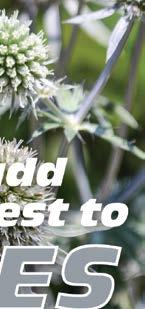

I have always admired plants with silver color, as this unusual shade can bring some variety to garden spaces.
Dusty Miller is a traditional landscape plant and one of my favorite hardy perennials, but it is also admired for its striking silver-gray foliage. Its finely lobed leaves are covered with a dense, silvery-white, felt-like coating that gives the plant a velvety texture and a frosty appearance.
Botanically known as Senecio cineraria, Dusty Miller belongs to the Asteraceae family. It can reach up to 12-18 inches tall and spreads 10-12 inches, forming a compact and bushy growth habit.
One of the reasons I love Dusty Miller is its ability to thrive in various growing conditions.
It does well in full sun to partial shade, making it a versatile addition to di erent parts of the garden. It prefers well-drained soil and can tolerate poor soil conditions, which is ideal for low-maintenance gardening. Dusty Miller is also drought-tolerant, reducing the need for frequent watering once established.
Although grown as a perennial in warm climates, Dusty Miller is often treated as an annual in cooler regions. When grown as a perennial, it may produce small yellow flowers in the second year. Some gardeners prefer to remove these flower stalks to maintain the plant’s neat and compact appearance.
Dusty Miller pairs beautifully with a wide range of plants, o ering a striking contrast to brightly colored flowers and green foliage. Its silver-gray leaves create a stunning backdrop for blooms like marigolds, petunias, and geraniums. It also works well in monochromatic gardens, adding texture and interest alongside other silver and white plants.
Sea Holly is another striking perennial that I prize for its unique, architectural appearance and silver color. Its sti , serrated leaves with a greenish hue and a distinctive silver metallic sheen add bold texture to gardens.
Sea Holly is another striking perennial that I prize for its unique, architectural appearance and silver color. Its sti , serrated leaves with a greenish hue and a distinctive silver metallic sheen add bold texture to gardens.
The plant’s foliage remains attractive throughout the growing season, adding a continuous silver accent to garden beds, borders, and containers.
Sea Holly produces thistle-like flowers of blue, purple and silver which sit atop tall, branching stems. These flowers have a spiky, spherical form that adds an unusual and eye-catching element to gardens.
This plant also draws bees and butterflies with its nectar-rich blooms.
Like Dusty Miller, Sea Holly prefers well-drained soil and can thrive in full sun to partial shade. It is drought-tolerant and deer-resistant, making it an excellent choice for low-maintenance gardens.
Licorice Plant Icicles is another popular ornamental I adore for its striking silver foliage. I appreciate how this plant adds a delicate and frosty element to a garden.
Its unique, silvery-white leaves are elongated, narrow, pointed and covered with fine hairs that resemble icicles. The foliage is soft to the touch and very aromatic when crushed.
The Icicles plant is hardy in U.S. Department of Agriculture zones 9-11, which includes a portion of south Mississippi. In cooler climates, it is often grown as an annual or used in containers that can be brought indoors during winter.
If you’re looking to add some variety to your landscape, consider the dynamic shape and color of these silver plants.

by Dr. Eddie Smith
Southern Gardening columnist Dr. Eddie Smith, a gardening specialist and Pearl River County coordinator with the Mississippi State University Extension Service, is an internationally certified arborist, Produce Safety Alliance certified trainer, and one of the developers of the Mississippi Smart Landscapes program that encourages the use of native plants in the landscape.





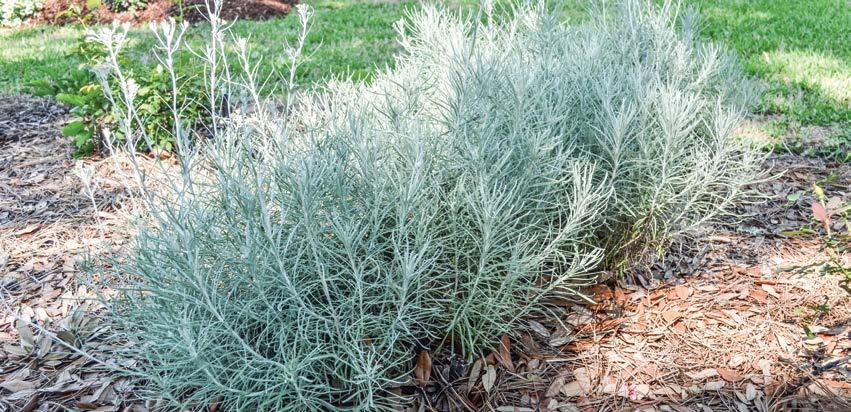












Propelled by powerful, broad wings, massive birds are headed directly toward us at deceptively fast speeds.
Crouching in the blind, we waited for the first wave of feathered overcast to come into range. Soon, the large boisterously honking birds cleared the golf course on the other side of our pond. Moments later, the giant birds descended lower to look over our decoys floating on the pond.
By the early 20th century, overhunting and habitat lost greatly reduced the population of the giant Canada goose subspecies. Wildlife managers thought this magnificent bird became extinct in the 1950s. Fortunately, someone discovered a small flock in Minnesota.
From that remanent, wildlife managers began breeding and


releasing the huge waterfowl all over the nation. Much larger than other Canada goose subspecies and raised in pens, the original o spring and their progeny did not migrate.
In the past few decades, exploding populations of gigantic resident honkers, sometimes derisively mocked as “golf course geese,” became pests in many places. The resident geese became so numerous that Mississippi now allows a special September season for these giant non-migratory birds.
In the summer, geese head to large waterbodies to molt, or shed their feathers. At this time, the flightless birds become vulnerable to predators, so they look for safe havens, such as parks and golf courses. The big birds can make a mess wherever they go. They leave their droppings everywhere.


As

for
By August, they replace their flight feathers. As fall approaches, geese split into smaller groups and look for ripening grain to eat. The large, voracious birds can do serious damage to crop fields. They eat all the grain and pull the plants up by their roots. A flock of geese can strip a crop field in a short time, leaving nothing, but dirt and droppings.
Therefore, many farmers hate the geese. Traditionally, many Mississippi landowners lease out portions of their properties for hunting to clubs at expensive rates. When it comes to the geese, many landowners welcome waterfowl hunters on their properties.


fall approaches, geese split into smaller
groups and look
ripening grain to eat. The large, voracious birds can do serious damage to crop fields. They eat all the grain and pull the plants up by their roots.













Sportsmen could drive around looking for concentrations of the big birds. After finding a bunch of Canada geese, they could ask the farmer or landowner for permission to hunt the property. Many landowners will greet such a request enthusiastically and quickly grant permission.
Other goose species populate Mississippi every fall and winter. At the end of the Mississippi Flyway, the Magnolia State typically attracts large numbers of migratory ducks and geese each year. The birds frequently follow the Missouri and Mississippi Rivers from their breeding grounds in the northern Great Plains down to the Gulf of Mexico. The Mississippi River Alluvial Valley in western Mississippi provides one of the critical wintering waterfowl habitats in North America. Lakes, rivers, and agricultural fields provide more waterfowl habitat.
The 2024 Mississippi season on resident Canada geese runs from Sept. 1 to Sept. 30 with a limit of five per person, per day. Other goose seasons open later in the fall.

by John N. Felsher


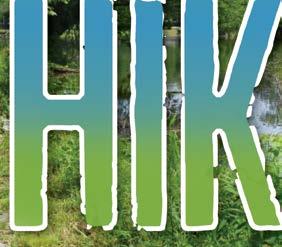







by Nick Thomas
After navigating primitive forest trails, hikers generally don’t expect to encounter a multimillion-dollar science museum at the end of their trek. However, this unique reward awaits visitors who complete the fairly easy mile-and-a-half nature trail through LeFleur’s Blu State Park and reach the state-of-the-art Mississippi Museum of Natural Science in Jackson.
“It’s a unique connection between a Mississippi State Park and a museum,” said T.J. Drummond, the museum’s visitor and volunteer services manager. “You can experience nature by walking through the park, then learn about it and much more at the museum.”
As cooler fall weather begins rolling across the Southeast, it’s the perfect season to explore the 305acre park. The nature trail guides visitors through a woodland forest, past scenic swamplands, along the Pearl River, and around Mayes Lake, where birds and other wildlife are often spotted. Trail markers help identify the diverse animals and plants found within the park.

trail from the park to the museum and begin just past the park’s campground that can be reached from the Lakeland Terrace side, o Lakeland Drive. One short trail runs parallel to the lake, but the Pearl River Trail veers o to the left toward the museum.
It’s a unique connection between a Mississippi State Park and a museum. You can experience nature by walking through the park, then learn about it and much more at the museum.
The trail ends at a series of rustic staircases where some 75 stairs lead up to a small amphitheater and, just past the open-air site, a primeval display greets visitors – six large 3D dinosaur models including a T. rex and Triceratops stationed as permanent outdoor exhibits at the museum since 2022. From there, the museum building can be accessed with more recent dinosaur additions featured in a new exhibit, ‘Dinosaurs Around the World: The Great Outdoors Exhibit,’ on display until Jan. 5 next year.
Conditions can be muddy or quite saturated after heavy rain, but footbridges and simple boardwalks direct walkers over streams and low points along the park’s color-coded trails. The purple (Pearl River) and red (Old River Run) trails make up most of the nature
“Visitors will be whisked back in time on a dinosaur adventure to come face-to-face with the giants of the past!” said Angel Rohnke, the museum’s director. “In this outdoor and indoor exhibition featuring 11 animatronic dinosaurs and cutting-edge research, visitors will tour an Earth that is very di erent from the one we inhabit today and learn about dinosaurs like T. rex and the Oviraptor, tectonic plates, geological formations, and the latest paleontological research.”





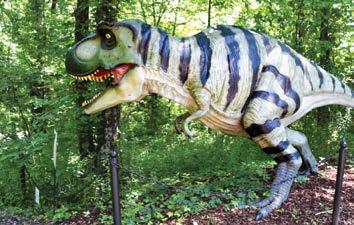



In addition to the dinosaur displays, the museum features a series of permanent and temporary exhibits throughout its 73,000-square-foot space including a 100,000-gallon aquarium network, and a 1,700-square-foot swamp greenhouse. More than a museum, the facility is also an operating research center where Mississippi’s fauna and flora are studied, and the state’s biological resources have been documented since the museum was first established in 1932 at its original downtown location. Next year will be the 25th anniversary of the museum’s move to the current LeFleur’s Blu State Park site.

Displays also highlight Mississippi’s endangered species and a wall is devoted to fossil specimens. While dinosaur fossils have been unearthed in the state, their distribution is limited.
“Dinosaurs have only been recovered in northeast Mississippi, where deposits of that age are exposed at the surface,” said George Phillips, the museum’s chief paleontologist. “There are no ‘dinosaur age’ deposits exposed in central Mississippi.” Phillips and his research team made a major discovery several years ago after finding a tooth in Union County which he said is “the only horned dinosaur (Ceratopsidae) fossil ever to be recovered from Eastern North America.” He expects the tooth to be added to the museum’s fossil wall display when it’s next updated.




Visitors not wishing to hike the longer trail through the park to the museum can tackle several short trails (the Old Pond, Cypress Trails, and Overlook Loop) behind the museum or access the museum directly through the front entrance o I-55. There they will not only be greeted by the giant dinosaur structures but also a children’s museum and an elaborate playground that kids of all ages will enjoy.
“Our museum and park have inspired countless visitors to appreciate and conserve the rich biodiversity of our state,” Rohnke said. “By o ering educational programs, interactive exhibits, and a beautiful natural setting, we continue.”
Nick Thomas writes features, columns, and interviews for many magazines and newspapers. See www.getnickt.org.
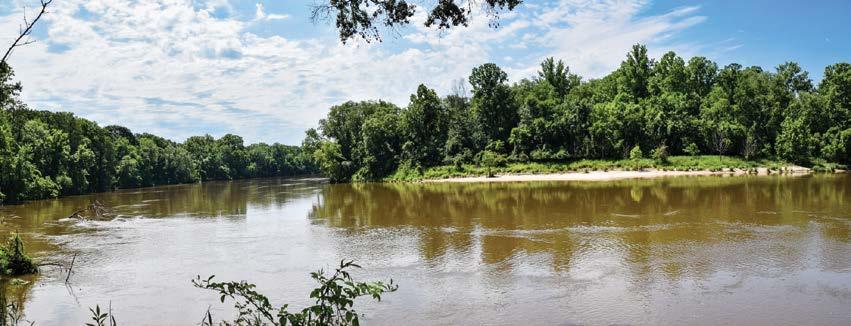


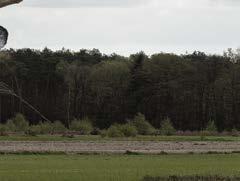



and White-winged Doves (Statewide)
Mergansers, and Coots**
Geese: Canada, White-fronted, Snow, Blue, Ross’, and Brant
Youth, Veterans, and Active Military Waterfowl Days
Light Goose Conservation Order*** (Special Permit Needed)
28 – Dec. 1 Dec. 7 - Jan. 31
Nov. 11 - Nov. 24
Nov. 28 - Dec. 1
Dec. 7 - Jan. 31 Canada Geese : 5 Snow, Blue, & Ross’: 20 White-fronted: 3 Brant: 1
Feb. 8 - 9, 2025
Canada Geese : 15 Snow, Blue, & Ross’: No limit White-fronted: 9 Brant: 3
Oct. 1 - Nov. 10
Youth (Private, authorized state and federal public lands, and open public lands. Youth 15 and under)
Nov. 25 - Nov. 27
Dec. 2 - Dec. 6
Feb. 1 - Feb. 7
Feb. 10 - Mar. 31
*Sept. Canada Goose season is closed on Roebuck Lake in Leflore county.
Mar. 8 - 14
One (1) adult gobbler or 1 gobbler with a 6-inch or longer beard per day, 3 per Spring season. Hunters 15 years of age and younger may harvest 1 gobbler of choice (any age) per day, 3 per Spring season.
* Non-residents Turkey Hunting on Public Lands: Non-residents cannot hunt any public land in Mississippi before April 1 unless drawn for either a Non-resident Public Lands Turkey Permit or WMA Draw Hunt. During youth season on public land, any non-resident accompanying adult must be permitted/ drawn.
**The duck daily bag limit is a total of 6 ducks, including no more than 4 mallards (no more than 2 of which may be females), 1 mottled duck, 2 black ducks, 1 pintail, 3 wood ducks, 2 canvasbacks, and 2 redheads. The daily bag limit for scaup is 1
* Non-residents Turkey Hunting on Public Lands: Non-residents cannot hunt any public land in Mississippi before April 1 unless drawn for either a Non-resident Public Lands Turkey Permit or WMA Draw Hunt. During youth season on public land, any non-resident accompanying adult must be permitted/ drawn.
28 – Dec. 1 and Dec. 7 – 17; and is 2 scaup per day Dec. 18 – Jan. 31.


The merganser daily bag limit is a total of 5 mergansers, only 2 of which may be hooded mergansers.
The coot daily bag limit is a total of 15 coots.

The possession limit is three times the daily bag limit for ducks, mergansers, and coots.


Shooting hours for all migratory game birds are from one-half hour before sunrise to sunset, except for the Light Goose Conservation Order (see below).



***The Light Goose Conservation Order is a special opportunity designed to reduce the population of overpopulated snow, blue, and Ross’ geese when no other waterfowl seasons are open. This order allows for expanded methods of take that are not allowed during regular waterfowl seasons. To participate in the Light Goose Conservation Order, hunters need a valid Mississippi hunting license, state waterfowl stamp, and a free Light Goose Conservation Order permit number. Hunters can obtain a permit number by visiting mdwfp.com/waterfowl.
Light Goose Conservation Order Methods: Shooting hours are from ½ hour before sunrise to ½ hour after sunset. Only snow, blue, and Ross’ geese are eligible for harvest. The use of electronic calls is allowed. The use of unplugged shotguns is allowed. There is no daily or possession limit for snow, blue, or Ross’ geese. Hunters must use non-toxic shot. Hunters must possess a valid Mississippi hunting license and a Mississippi state waterfowl stamp. Light goose conservation order hunters do not need a federal duck stamp.


ANTLERED
The statewide bag limit on antlered buck deer is one (1) buck per day and three (3) per annual season. One (1) of these three (3) may have hardened antlers that do not meet the unit legal antler requirements on private land and Holly Springs National Forest. Only one antlered buck may be harvested during the September archery velvet season (counts toward the annual bag limit). For youth hunters fifteen (15) years of age and younger, hunting on private land and authorized state and federal lands, all three (3) of the three (3) buck bag limit may be any antlered deer. Antlered buck bag limit in the NorthCentral Deer Management Unit (DMU) is one (1) buck per day and four (4) per annual season. No antler restrictions apply to this DMU. All four bucks may have any sized hardened antlers.
Private lands: Private lands: The statewide annual bag limit on antlerless deer is five (5). The antlerless bag limit for private lands in the North Central DMU is ten (10) antlerless deer per season. Antlerless deer are male or female deer which do not have hardened antler above the natural hairline. Only three (3) antlerless deer may be harvested from the Southeast Unit. There is no daily bag limit on antlerless deer in the North Central, Hills, and Delta units. Only one (1) antlerless deer per day may be harvested in the Southeast DMU.
U.S. Forest Service National Forests: The bag limit is one (1) per day, not to exceed five (5) per annual season except in the Southeast Unit, which is three (3) per annual season.
U.S. Forest Service National Forests: The bag limit is one (1) per day, not to exceed five (5) per annual season except in the Southeast Unit, which is two (2) per annual season.
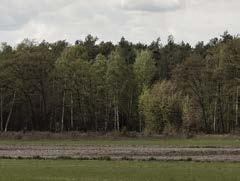
A legal buck is defined as having EITHER a minimum inside spread of 12 inches OR one main beam at least 15
A legal buck is defined as having EITHER a
How to estimate a 12 inch inside spread:
How to estimate a 12 inch inside spread:
Estimating a 12 inch spread is accomplished by observing a
Estimating a 12 inch spread is accomplished by observing a
To estimate a 15 inch main beam, the buck’s buck’s ears in the alert position. When in the alert position, the head must be observed from the side. If the distance from ear-tip to ear-tip measures approximately 15 tip of the main beam extends between the inches. If the OUTSIDE of each antler beam reaches the ear-tip, front of the eye and the tip of the nose, main the inside spread is approximately 12 inches. (Therefore, if the beam length is approximately 15 inches. outside of both antler beams reach the ear tips, the buck is legal).
To estimate a 15 inch main beam, the buck’s buck’s ears in the alert position. When in the alert position, the head must be observed from the side. If the distance from ear-tip to ear-tip measures approximately 15 tip of the main beam extends between the inches. If the OUTSIDE of each antler beam reaches the ear-tip, front of the eye and the tip of the nose, main the inside spread is approximately 12 inches. (Therefore, if the beam length is approximately 15 inches. outside of both antler beams reach the ear tips, the buck is legal).
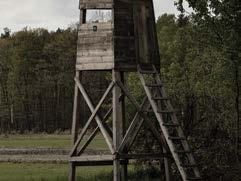
*Due to body size differences in the Delta Unit, ear-tip to ear-tip measurements are slightly larger compared to the other units.
*Due to body size differences in the Delta Unit, ear-tip to ear-tip measurements are slightly larger compared to the other units.

A legal buck is defined as having EITHER a minimum inside spread of 10 inches OR one main beam at least 13 inches long. How to estimate a 10 inch inside spread: How to estimate a 13 inch main
NORTH
DELTA, NORTH CENTRAL, AND HILLS DEER MANAGEMENT UNITS METHOD SEASON DATES LEGAL DEER
METHOD SEASON DATES LEGAL DEER
Archery Sept. 13 - 15
Estimating a 10 inch spread is accomplished by observing a
Archery Sept. 13 - 15
buck’s ears in the alert position. When in the alert position, head must be
Only one (1) Legal Buck Special permit, mandatory reporting, and CWD sampling required. Private Land and authorized state and federal lands. Oct. 1 - Nov. 22
Only one (1) Legal Buck Special permit, mandatory reporting, and CWD sampling required. Private Land and authorized state and federal lands Oct. 1 - Nov. 22
from the
If the the distance from ear-tip to ear-tip measures approximately tip of the main beam extends to the front of 14 inches. If the OUTSIDE of each antler beam is 1 inch inside the eye, main beam length is approximately the ear-tip, the inside spread is approximately 10 inches. 13 inches.
Youth Season (15 and under) Nov. 9 - Nov. 22
Youth Season (15 and under) Nov. 9 - Nov. 22
Either-Sex on private land, open public land, and Holly Springs NF
Either-Sex on private land, open public land, and Holly Springs NF
Either-Sex on private lands, authorized state and federal lands, and open public lands. Nov. 23 - Jan. 31
Either-Sex on private lands, authorized state and federal lands, and open public lands. Nov. 23 - Jan. 31
Either-Sex on private lands. On open public lands, youth must follow below legal deer criteria.
Either-Sex on private lands. On open public lands, youth must follow below legal deer criteria.
Antlerless Primitive Weapon Nov. 11 - 22 Antlerless Deer Only on private lands.
A legal buck is defined as having EITHER a minimum inside spread of 12
Antlerless Primitive Weapon Nov. 11 - 22
Gun (with dogs) Nov. 23 - Dec. 1
Gun (with dogs) Nov. 23 - Dec. 1
How to estimate a 12 inch inside spread:
Primitive Weapon Dec. 2 - 15
Primitive Weapon Dec. 2 - 15
Gun (without dogs) Dec. 16 - 23
Gun (without dogs) Dec. 16 - 23
Gun (with dogs) Dec. 24 - Jan. 22
Gun (with dogs) Dec. 24 - Jan. 22
*Due to body size differences in the Delta Unit, ear-tip to ear-tip measurements are slightly larger compared to the other units.
Archery
Antlerless Deer Only on private lands.
OR
Either-Sex on private land and Holly Springs NF. Legal Bucks only on open public land.
Either-Sex on private land and Holly Springs NF. Legal Bucks only on open public land.
Either-Sex on private land, open public land, and Holly Springs NF. Weapon of choice may be used on private land with appropriate license.
Estimating a 12 inch spread is accomplished by observing a To estimate a 15 inch main beam, the buck’s buck’s ears in the alert position. When in the alert position, the head must be observed from the side. If the distance from ear-tip to ear-tip measures approximately 15 tip of the main beam extends between the inches. If the OUTSIDE of each antler beam reaches the ear-tip, front of the eye and the tip of the nose, main the inside spread is approximately 12 inches. (Therefore, if the beam length is approximately 15 inches. outside of both antler beams reach the ear tips, the buck is legal).
Either-Sex on private land, open public land, and Holly Springs NF. Weapon of choice may be used on private land with appropriate license.
Either-Sex on private land and Holly Springs NF. Legal Bucks only on open public land.
Either-Sex on private land and Holly Springs NF. Legal Bucks only on open public land.
Either-Sex
on private land with appropriate license.
Sept. 13 - 15
13 - 15
Oct. 15 - Nov. 22
Archery Sept. 13 - 15 Only one (1) Legal Buck Special permit, mandatory reporting, and CWD sampling required. Private Land and authorized state and federal lands. Oct. 15 - Nov. 22
Oct. 1 - Nov. 22
Only one (1) Legal Buck Special permit, mandatory reporting, and CWD sampling required. Private Land and authorized state and federal lands.
Either-Sex on private land, open public land, and Holly Springs NF
Either-Sex on private and open public land.
Youth Season (15 and under) Nov. 9 - Nov. 22
Youth Season (15 and under) Nov. 9 - Nov. 22
Either-Sex on private lands, authorized state and federal lands, and open public lands. Nov. 23 - Jan. 31
Either-Sex on private lands, authorized state and federal lands, and open public lands. Nov. 23 - Feb. 15
Gun (with dogs) Nov. 23 - Dec. 1
Antlerless Primitive Weapon Nov. 11 - 22
2 -
Gun (with dogs) Nov. 23 - Dec. 1
Primitive Weapon Dec. 2 - 15
Gun (without
Either-Sex on private lands. On open public lands, youth must follow below legal deer criteria.
Either-Sex on private lands. On open public lands, youth must follow below legal deer criteria.
Antlerless Deer Only on private lands.
Gun (with dogs) Nov. 23 - Dec. 1 Either-Sex on private land. Legal Bucks only on open public land.
Either-Sex on private land and Holly Springs NF. Legal Bucks only on open public land.
Either-Sex on private and open public land. Weapon of choice may be used on private land with appropriate license.
Primitive Weapon Dec. 2 - 15
Gun (without dogs) Dec. 16 - 23
Gun (with dogs) Dec. 24 - Jan. 22
Gun (without dogs) Dec. 16 - 23
Archery/Primitive Weapon Jan. 23 - 31
Gun (with dogs) Dec. 24 - Jan. 22
Archery/Primitive Weapon Jan. 23 - 31
Either-Sex on private land, open public land, and Holly Springs NF. Weapon of choice may be used on private land with appropriate license.
Either-Sex on private land. Legal Bucks only on open public land.
Either-Sex on private land and Holly Springs NF. Legal Bucks only on open public land.
Either-Sex on private land. Legal Bucks only on open public land.
Either-Sex on private land. Legal Bucks only on open public land. Weapon of choice may be used on private land with appropriate license. Feb. 1 - 15 Legal Bucks only on private and open public land. Weapon of choice may be used on private land with appropriate license.
Either-Sex on private land and Holly Spring NF. Legal Bucks only on open public land.
Either-Sex on private land and Holly Springs NF. Legal Bucks only on open public land. Weapon of choice may be used on private land with appropriate license.

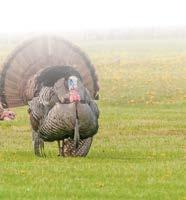

* Non-residents Turkey Hunting on Public Lands: Non-residents cannot hunt any public land in Mississippi before April 1 unless drawn for either a Non-resident Public Lands Turkey Permit or WMA Draw Hunt. During youth season on public land, any non-resident accompanying adult must be permitted/ drawn.



















• Rate schedule is based on your current age and is guaranteed for the life of the policy.
• Coverage is also available for your spouse and other family members.
• Benefits will NEVER be canceled or reduced for the life of the policy if premiums are paid on time.
Policy Form #SRTCV/SRTCV R13 or R17, or #SRTCV90MA in MA
CA Residents, for your consumer rights, please visit beginglobeinsurancetoday.com/privacy.
(Offer













• Rates are based on your children’s or grandchildren’s present age and never increase for any reason.
• Benefits will NEVER be reduced or canceled if premiums are paid on time.
• Give your children a financial head start right now. Your policy builds CASH VALUE for your family’s needs.
Policy Form #GWL2001 or GWLA001










On October 1, Southern Pine will kick o our Members Helping Members program. With this program, your bill will automatically be rounded up to the nearest dollar and used to support our communities. Members Helping Members is a simple, voluntary way to make a big di erence, and the money goes towards helping the people Southern Pine serves.
For example, a bill of $82.75 would be rounded up to $83. The extra .25 cents is placed in the Members Helping Members Trust Fund, which provides fi nancial support for charitable causes and non-profit organizations within the 11 counties Southern Pine serves. Your spare change can fund charitable projects, equip emergency services, upgrade classrooms and playgrounds, and more. The average amount a participating member contributes is about $6 a year.
If the Members Helping Members program isn’t right for you, opting out is straightforward. You can do so by scanning the QR code on below, visiting Southern Pine.coop/MHM, or just giving us a call. Before you decide, consider the collective impact of this program.
I understand that $6 a year may not seem like much, but when combined with all the members of Southern Pine, it can make a significant di erence in our communities.
The 7 Cooperative Principles guide Southern Pine and other electric cooperatives in everything we do, and one of the principles is Concern for Community. Members Helping Members allows all of us to come together to fulfill that principle. Together, we can make a significant impact and help our communities for years to come.

by Chris K. Rhodes
President/CEO Southern Pine Electric
Your spare change can make a big di erence through the Members Helping Members Program. Participating Southern Pine members’ bills are rounded up to the nearest dollar, and the amount collected benefits members in Southern Pine’s 11-county service area. For less than two cents a day, you can be part of making a meaningful impact right here at home. Working together, the cooperative way, we can make a di erence.
SCAN TO LEARN MORE OR OPT OUT
































Being a Southern Pine Electric Cooperative member is di erent from simply being a customer. Our members are invited and encouraged to be active in the cooperative, and the co-op has a responsibility of involvement in the communities we serve. It is one of the guiding principles that we abide by in our day-to-day work. That is why we are launching a new voluntary program, Members Helping Members, where members can help support each other, and their own communities.
While this program, commonly known as Operation Round-Up, is new to our members, it has a proven history of success across the United States and at other co-ops in Mississippi. For decades, these programs have benefitted thousands of rural electric cooperative members, and now, we are excited to be able to help our members enjoy the same proven benefits through Members Helping Members.
By rounding up your electric bill, averaging .50 cents a month, you can help area charities, students, teachers, educational projects, safety programs, shelters, senior citizens, and numerous other community service projects that can directly benefit you and your family. Funds stay in the 11-county area served by Southern Pine, helping to make life better for you, your family, and neighbors.
Beginning in October 2024, bills will be rounded up to the nearest dollar. For instance, if your bill is $145.50, it will be rounded to $146. On average, members will donate around $6 annually per account to the program. While this may seem like a small amount, we can make a significant di erence by using pocket change to make a lasting impact in local communities.
Through members’ generosity, and participation in this program, we can help bring hope and opportunity to our own communities. This is just one more example of what it means to belong to a cooperative and how a tiny bit of change can make an enormous di erence.
Contributions will be placed in a separate, audited Members
Helping Members Trust Fund administered by the Pinebelt Foundation, a charitable organization described in Sections 501(c )(3) and 509 (a(1) of the Internal Revenue Code. Acting as a charitable support service provider, the Pinebelt Foundation has been helping charities for over 25 years. Southern Pine’s board of directors, management, or employees will not make decisions on the awarding of funds.
To ensure that members know their donations will go to worthwhile community causes within the co-op’s service territory, and that members are actively participating in the process, an 11-member advisory committee, consisting of one member from each county served – Copiah, Covington, Newton, Scott, Simpson, Forrest, Jasper, Je erson Davis, Smith, Lawrence, and Rankin -- will be selected. The advisory committee will review grant applications, after the Pinebelt Foundation has verified eligibility, and recommend awards. Each advisory committee member will serve for three years, and then other Southern Pine members will be selected to serve.
“We hear from our members that they want us helping in their communities to promote service programs that benefit their families and others. We can do that through Members Helping Members in a painless way. The average monthly contribution is less than the price of a canned drink. We could not make a di erence doing it alone, but if we join together, in the cooperative spirit, then we can make an enormous di erence. This program allows us all to help each other, and I am happy to be a part of it,” said Jan Collins, vice president of communications.
We hope you will be as eager as we are to bring the benefits from this program to your family, neighbors, and communities. However, we want to emphasize that participation is entirely voluntary, and members may opt out at any time. If you decide not to participate, we have made opting out easy. Scan the QR code to find out more information or to opt out. Complete the short form and you will be opted out of the program. You can also complete the opt-out form on the Southern Pine website, at www.southernpine.coop/MHM, email us at optout@southernpine.coop, or call us at 800-231-5240. The choice is yours.

SCAN TO LEARN MORE OR OPT OUT









































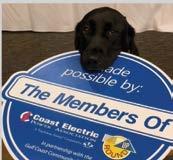




There are hundreds of co-ops that participate in round-up programs across the nation. Each program directly benefits the members of the individual cooperative and funds stay within its service territory. Check out a few of the ways 4-County Electric and Coast Electric help their co-op’s members and then imagine the impact Members Helping Members can have within the communities we serve.



Over 55 Southern Pine members from Copiah County joined us for the Copiah County Member Circle in early August at the Family Fish House in Hazlehurst. Members enjoyed great food and fellowship and heard from Brandon Henderson, the New Hebron District Manager. Henderson spoke about the New Hebron District, and employees were on hand to answer any questions.
Jan Collins, Vice-President of Communications at Southern Pine, spoke with the group about several programs that could be helpful. She gave an overview of the new bill format, discussed texting for outages, and introduced the new round-up program, Members Helping Members, and how beneficial the program will be to all counties in Southern Pine’s service territory.
“I love Member Circle meetings because we get to fellowship with the members, discuss important topics, and listen to members’ questions and concerns,” said Collins. “Our goal in the communications department is to be transparent in everything we do because the members are the owners of Southern Pine and have a stake in our success. We want to talk about the great things happening, but we also want to address any issues they may be having and try to help find solutions.”

Charles Lowe, Southern Pine board member from Copiah County, and Billy Berry, Southern Pine board president from Simpson County, attended the event to meet some of the members they serve.
Southern Pine holds Member Circle events in each of the 11 counties we serve on a rotating basis. We look forward to being in your county soon.

















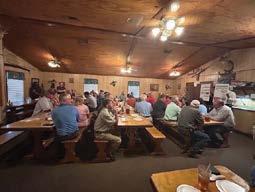
Purvis, MS - If you experience numbness or tingling in your hands, arms, legs, or feet or if you experience shooting or burning pain, this is important.
Please read this carefully

Peripheral Neuropathy is when small blood vessels in the hands, arms, feet or legs become diseased and tiny nerves that keep the cells and muscles working properly shrivel up and die.
Early-warning symptoms include tingling and numbness, mild loss of feeling in your hands, arms, legs or feet, inability to feel your feet, which increases your risk of foot-injury and falling
More Advanced Symptoms Include...
Loss of coordination & dexterity, which puts you at increased risk of accidents
Inability to feel clothing like socks and gloves
High risk of falling, which makes walking dangerous, and makes you more dependent on others
Burning sensations in your arms, legs, hands or feet that may start mild, but as nerves and muscles die, may feel like you're being burned by a blow torch.
Ignore the early warning signals long enough and you risk progressive nerve damage leading to muscle wasting, severe pain, loss of balance and a lot of staying at home wishing you didn't hurt
When every step is like walking on hot coals, sitting still may be the only thing you feel like doing But there's little joy in sitting still all day long

Now here's the scary part....
Nerve damage CAUSES cell damage Cell damage SPEEDS UP nerve degeneration
Without treatment this can become a DOWN-WARD SPIRAL that accelerates.
The damage can get worse fast Mild symptoms intensify Slight tingling, numbness or lack of feeling can turn into burning pain.
Before you know it, damage can become so bad you hurt all the time
Unless this downward spiral is stopped and nerves return to proper function - the damage to nerves and cells in the affected area can get so bad your muscles begin to die right along with the nerves and cells. And that sets the stage for weakness, loss of mobility, disability, and dependence on others.
If you have early warning signs of peripheral neuropathy, (tingling &/or numbness, loss of feeling or pain) it's CRITICAL you get proper treatment
It's critical, because with proper treatment the symptoms can often be reversed Without it, you are playing Russian Roulette with your health
Once your nerve loss reaches 85%, odds are there's nothing any doctor can do to help.
The most common method your doctor may recommend to treat neuropathy is prescription drugs

Drugs like Gabapentin, Lyrica, Cymbalta, & Neurontin are often prescribed to manage the pain But, damaged nerves and dying cells do not heal on their own
Pain pills do not restore healthy nerve function. They just mask the pain as the nerves continue to degenerate and cells and muscle continue to die.
Taking endless drugs and suffering terrible side effects that may damage your liver & kidney and create even more problems, is not a reasonable path. You deserve better. Three things must be determined to effectively treat neuropathy 1) What is the underlying cause? 2) How much nerve damage has been sustained? 3) How much treatment your condition will require?
With proper treatment, shriveled blood vessels grow back & nerves can return to proper function How much treatment you may need depends on your condition
At Purvis Chiropractic we do a complete neuropathy sensitivity exam to determine the extent of your nerve damage The exam includes a detailed sensory evaluation, extensive peripheral vascular testing, & a detailed analysis of the findings.
Dr Rob Acord, D C will be offering this complete neuropathy sensitivity exam for $47 This special offer goes away at the end of this month as we have a limited number of exam appointments available
Stop Hurting & Start Healing
Call



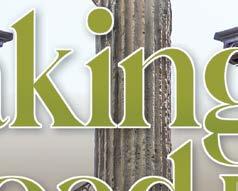







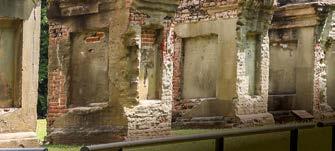

by Steven Ward
If you live near The Natchez Trace Parkway in Mississippi, you might avoid it for everyday trips — drives to work, home, or to run errands.
But if you are looking for a day or weekend trip to explore the state, “The Trace” is as close to perfect as anything in Mississippi.
The Natchez Trace Parkway is 444 miles that snake through Mississippi, Alabama, and Tennessee linking Natchez to Nashville.
Established as a unit of the National Park System in 1938 and o cially completed in 2005, the Trace — headquartered in Tupelo — has been declared a National Scenic Byway, an All-American Road, and has been chosen as one of the country’s 10 best biking roads.
The Trace provides a near continuous greenway from the southern Appalachian foothills of Tennessee to the blu s of the lower
Mississippi River. Along the way, visitors can spot Indian mounds, — including the largest in the United States — four ecosystems, and eight major watersheds that provide habitat for nearly 1,500 species of plants, 33 mammal species, 134 bird species, and 70 species of reptiles and amphibians, according to the Natchez Trace Compact.
The Trace is well known for bicycling, hiking, camping, and scenic driving opportunities.
“It provides visitors the opportunity for an unhurried trip through time. In addition, there are dozens of unique communities along the route and just beyond the trees. Visitors can explore anything from one of the nation’s fastest-growing cities (Nashville) to charming historic villages,” said Kim Foster, executive director of the Natchez Trace Compact.
The Mississippi communities along the Trace include Natchez, Claiborne County, Raymond, Clinton, Jackson, Ridgeland, French Camp, Chickasaw County, Tupelo, and Tishomingo County.
The Mississippi River town of Natchez is filled with historic buildings and churches, antebellum mansions, four National Park sites, and a walkable downtown area.
• The Museum of African-American History and Culture (601-445-0728/visitnatchez.org)
• Trinity Episcopal Church (601-445-8432/ trinitynatchez.org)
• Fat Mama’s Tamales (601-304-2379/ fatmamastamales.com)










Claiborne County sits between the Mississippi River and the Big Black River and is about 44 minutes away from Vicksburg and an hour away from Natchez. The county includes the community of Port Gibson. Lorman — an unincorporated area in Je erson County — is nearby and home to the nation’s first land-grant historically black college university.
• Alcorn State University (601-877-6100/alcorn.edu)
• Port Gibson is the location of the Windsor Ruins, a former plantation home destroyed by fire in 1890 with 45-foot-tall masonry columns still standing. (mdah.ms.gov/explore-mississippi/windsor-ruins)
• Grand Gulf Military Park is a 450-acre landmark on the National Register of Historic Places with campgrounds, a museum with artifacts from the Civil War, picnic areas, and an observation tower. (601-437-5911/grandgulfpark.ms.gov).
• Rocky Springs is near Port Gibson and includes a scenic hiking trail and the remains of an old town including the Rocky Springs Methodist Church. where regular services are still held, and its neighboring cemetery. Yellow Fever hit Rocky Springs in 1878 and a icted 180 residents and killed 43 of them. (nps.gov/thingstodo/ rockyspringssection.htm)
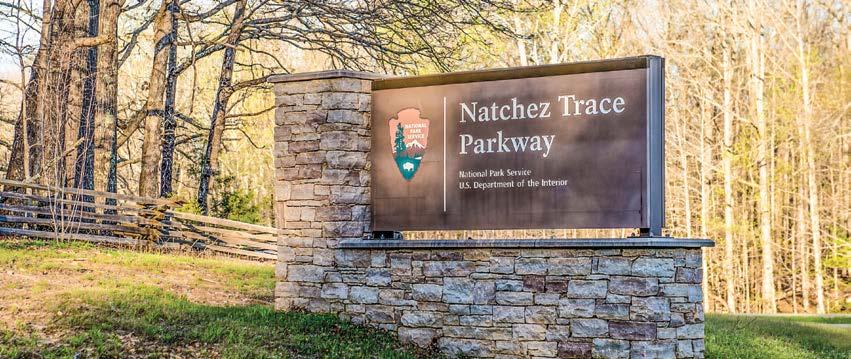
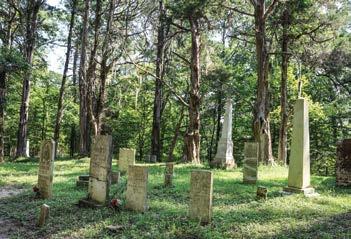



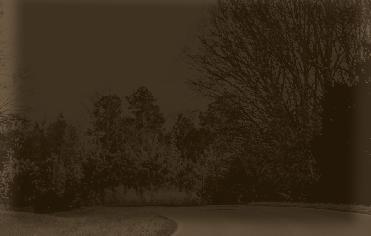
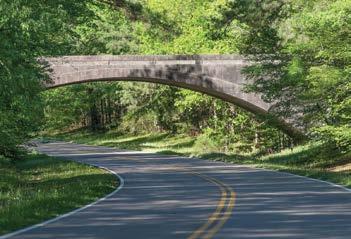


Raymond is a town in Hinds County that is rich in Civil War history.
• Places to visit in the area include a walking and driving tour of downtown Raymond. (601-857-8041/raymondms.com)
• Raymond Battlefield Park has a walking trail with interpretive markers and cannon placement. (natcheztracetravel.com/natchez-trace-mississippi/jacksonraymond-ms/347-raymond-military-park.html)
• The John Bell Williams Airport is in nearby Bolton. (601-857-3884/hindscc.edu/locations/john-bell-williams-airport)
The brick streets of Clinton’s olde towne feature an array of unique shops and restaurants.
• The Clinton Community Nature Center features miles of walking trails, a children’s play area, a seasonal splash pad, and historic landmarks. (601-926-1104/ clintonnaturecenter.org)
• Acclaimed artist Wyatt Waters’ art gallery is in Clinton as well. (601-925-8115/wyattwaters.com)
This area is known for French Camp Academy, a Christ-centered boarding school that is also the site of two other interesting attractions.
• French Camp Academy (662-547-9464/frenchcamp.org)
• French Camp Bed and Breakfast (662-547-6835/ frenchcamphistoricvillage.com)
• Rainwater Observatory is where visitors can experience astronomy education in a state-of-the-art planetarium and search the skies for stars and planets via the observatory’s powerful telescope. (662-547-7283/rainwaterobservatory.org)
The county’s small towns of Woodland, Houston, and Okolona o er recreation, food, o -road ATV trails, horseback riding, and plenty of history.
• The Bynum Mound, just six miles northeast of Houston and on the Trace Parkway, is where the Bynum Indians lived, hunted, and fished. The Indian mound is the oldest on the Natchez Trace. (nps.gov/places/bynum-mounds.htm)
• The Witch Dance, just outside of Houston, is famous for being a “haunted” campground. According to legend, witches once gathered there to dance, and wherever their feet hit the ground, the grass withered and died, never to grow again. (nps.gov/natr/witch-dance-bicycle-only-campground.htm)

Tupelo is the headquarters for the Natchez Trace Parkway and located in the northeast part of the state, intersected by the Trace, Highway 45, and Highway 78. Tupelo is Elvis Presley’s hometown. The King of Rock and Roll was born on Jan. 8, 1935, in a modest, two-room house that his father built with $180.
• The Elvis Presley Birthplace & Museum features Presley’s home, a chapel, and a park. (662-841-1245/elvispresleybirthplace.com)
• Tupelo also is home to the Tupelo Bu alo Park, where visitors can take a tour on the “Monster Bison Bus” to see bu alo up close. (662-844-8709/ tupelobu alopark.com)




Located in the foothills of the Appalachian Mountains and home to Woodall Mountain — the highest point in Mississippi — the county is filled with parks, caves, canyons, hiking trails, bridges, and streams for fishing and swimming. The county is also home to the country’s only apron museum.
• The Apron Museum at Pineslab Shop in Iuka features hundreds of vintage aprons to view and purchase. (662-279 2390/ tishomingofunhere.org/PDFs/ApronMuseumFlyer.pdf)
• Visitors can also take a Bear Creek canoe trip in Tishomingo State Park. (662-438-6914/mdwfp.com)
For more information about planning a trip down the Natchez Trace Parkway, visit the Natchez Trace Compact’s website at scenictrace.com or nps.gov/natr/index.htm

Visit Today in Mississippi’s Facebook page to watch a video of the Windsor Ruins, just off the Trace in Port Gibson.






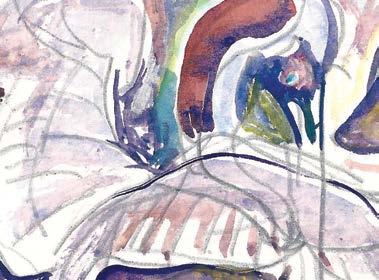


Whether you are exploring the coast or a local looking for a little get away, our new campground is the ideal place to stay. There’s plenty to do for all ages with pickleball, an adult pool, lazy river, hot tub, playground, doggie park, horseshoes, spa chair and more! And don’t forget to bring your pets along!
We offer premium tent sites with water and electric, 4 deluxe cabins with full baths, 4 cottages with 1/2 baths, rental campers, 8 sites with k9 playyaros, golf cart rentals, and a pavilion. All sites are equipped for 30 and 50 amp with full hookups, as well as have a firepit and patio, most also have grills. 3 Private showers and 2 bath houses.
Weekly, monthly, and holiday events
We are conveniently located 4 miles north of 1-10, just minutes from beaches, casinos, shopping, and many local attractions. Come see what all the buzz is about! 14031 Hwy 49N Gulfport, MS 39503

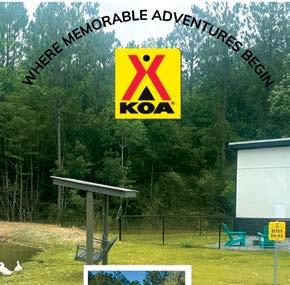
















































SEPTEMBER THRU OCTOBER
Mississippi coastal sculptor/painter Nina Cork shares her passion for the visual arts with an exhibition of her work over the past four decades.


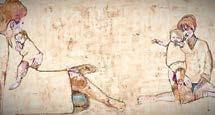
JOIN US OCTOBER 4-5 for the largest Plein Air Paint Out in Mississippi. Come paint beautiful Greenwood in the heart of the Delta.

MONTH OF NOVEMBER
Enjoy fascinating work from Turkishborn DSU Assistant Professor of Art and Animation Korkut Akacik and his wife Yelda Akacik.


MONTH OF DECEMBER
Lee Harper’s Miniature Dioramas are sure to enthrall young and old alike. Doe’s Eat Place has been shrunk to fit on a steak platter!



Fall is a great time for a day trip, and there’s no better place to visit than the Museum of the Mississippi Delta. Located in Greenwood, we’re just a short hop from most of north Mississippi and eastern Arkansas. Don’t pack a thing–just load up and head our way!
























